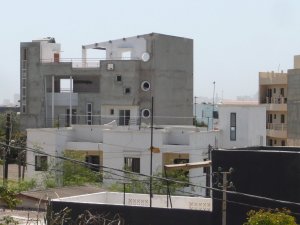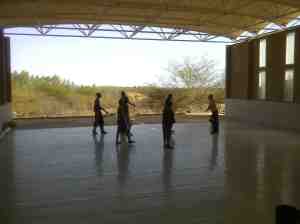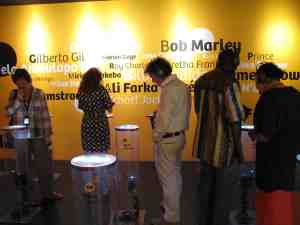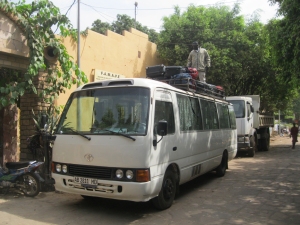Abou is the first Senegalese artist I meet. He starts to talk to me as soon as I step outside the hotel compound. I try to hold off like he is one of the many vendors swarming around but he insists and a conversation develops. Crossing the city on foot and back, we discuss the quality of the Dakar Biennal, what he perceived as a lack of local art and artists in the 3rd Festival Mondial des Arts Nègres; the importance of international connections, his current project called ‘What future for Africa?’ (Abou plans to travel to Libya and Cote d’Ivoire to photograph the revolution, Inshallah) and the trouble with government subsidies. Of course he will be at the opening at La Manège later tonight.

Metropole meets countryside in the Medina district
The impressive presentations by Koyo Kouoh and Jean-Charles Tall yesterday evening gave us a taste of the arts climate and the cultural situation in Dakar. Here it is ‘different’ from Mali, it seems. The program of today will put this impression to the test.
Morning brought us to Le Manège, just around the corner of our hotel in the Plateau district. Le Manège is the gallery space of the Institut Français. Director Delphine Calmettes is unable to meet us but luckily Christine Eyene took time to meet us and answer our questions. She is the curator of Kaddou Diggen (Women speak out) a group show with work by 8 female artists living and working in Africa or in the diaspora. Amidst the activities of a typically day-before-the-opening situation, Christine informed us on some of the exhibited pieces and of the theme of the exhibition, which is female identity in the arts as constructed by women.
Christine Eyene is a curator who studied in Paris and currently lives and works in London (parallel to “Kaddou Diggen” she is preparing an exhibition in the Southbank Centre). She considers herself part of a new generation of cultural professionals that emphasizes collaboration and exchange, and aims at breaking with the current notion of ‘African Arts’. One of her objectives is to bring African artists to the western world.
A slightly confused and (thus) interesting discussion occurred upon two questions. Jogi memorised that historically there used to be no difference between arts and artisanship; in the western world the two have become separated. How about Africa? Does she think this notion is relevant to the conceptual perspective and practice of her curatorial work? No!! Christine is engaged with the visual arts and its history.
Amila offered another angle: does the art from Africa imply new visions on the dominant linear pattern in which art historically emerged from visual culture and developed into a new discipline, detached from religion or crafts e.g.? In response Christine referred to an essay Okwui Enwezor wrote in Authentic/Ex-Centric: Conceptualism in Contemporary African Art (2001).
This visit brought about that there might be different paradigms at work in Mali and here in Dakar. Whereas in Mali the visual arts generally seem to be embedded in cultural and social practices, the scene in Dakar is clearly positioning itself within a western paradigm that supplies us with the language, codes and statements that are connected with ‘classical’ history of arts, even by adjusting or adding to it.
After Le Manège the bus delivered us in one of the so-called SICAP settlements, their streets lined with late modernist and comfortable urban villas built by the SICAP real estate company that has been active in Dakar since the 1950’s
Kër Thiossiane is a space for “multimedia and citizenship” and we met with coordinator Marion Legrand in a sunny but windy courtyard. She introduced us to various projects they have initiated since the start of the initiative in 2002 and toured us around their modest but spacious building. Activities are locally situated and often developed in collaboration with international partners. Ker Thiossane runs also an interdisciplinary and international residency program which draws in artists and musicians for productions, research or collaborations.

View from the roof

Meeting Marion Legrand
Their scope is interdisciplinary and ranges from dance to music to video art. With the lack of a new media department at the Dakar academy of art, this space seems to fill a gap and continues to contribute to the practice of and reflection on approaches to new technologies that are specific for the African continent. Marion stressed the importance of collaboration between institutions and cultural centers, which in Dakar cannot happen without effort.
With the help of a subsidy from the EU fund ACP Cultures, Ker Thiossane currently develops a two year project Rose de Vent Numerique (‘Digital Compass Rose’). Pairing medialabs in Mali, South Africa, Martinique, France and Finland, knowledge about electronic culture is being exchanged between continents. It has amongst others resulted in a first edition of the excellent Afropixel festival in Bamako and Dakar. Continue reading →











